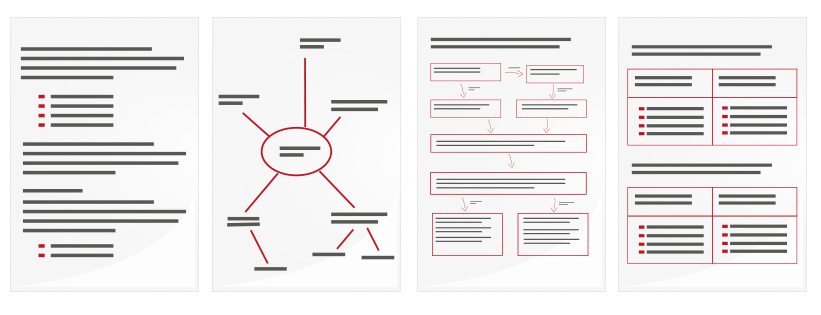Active listening in lectures
Prepare for lectures by reading recommended material in advance. Be an active not passive listener by making notes during the lecture, because:
- lecturers give more information in a lecture than is shown on the slides/handouts
- lecturers give hints/tips for assignment writing,
- note taking helps you extend your attention span.
Why are you making notes? Ask yourself – what do I already know about the subject? What additional information do I need? What questions do I want to answer?
Listen carefully to the start of a lecture to establish the structure of the session. Listen for ‘signposts’ e.g., ‘there are three key points’, ‘I want to emphasise’.
How do you make notes?
Research shows that writing notes by hand is more effective than typing them.

Linear
Linear notes are the simplest style of notes, both for reading and listening. Notes are written down the page, one line after the other. The use of numbering/lettering can help distinguish the main points.
Pattern
Pattern notes are notes which are not linear and are therefore beneficial to visual learners. There are lots of different Patterns, think about how you can use them, perhaps in combination with linear notes.
- Mind map - A mind map, also known as a spider-gram, is a diagram in which ideas are linked to each other by lines, usually starting from the middle and working outwards. Although it can be used at any time, it is best when there is one main topic
- Flow chart - Useful if you want to show a process or a change over time.
- Table - This is most used when two different things are compared.
Formatting and writing style
In general, it is good to make use of:
- key words and phrases
- colour
- signs
- symbols
- subheadings (to group information)
- number points
- linked up points (use arrows, dotted lines)
Take notes in your own words. Do not write full sentences. Develop your own shorthand but make sure you can read your notes later.
Do not cram too much on the page. Use wide margins to leave room to add additional notes later.
Keep track of your notes
- Organise your notes so that you can easily find what you are looking for. If you have several pages on one topic, include page numbers.
- Add a Title to your notes and date them.
- Always record the source/s of your notes – which you will need to reference in your assignment.
- Review your notes as soon as you can after making them – do they make sense?
- Highlight important points: draw ‘boxes’ or ‘rings’ in colour round sections of notes to make them stand out.
- Add to your notes but only copy them out in ‘neat’ if you change the notes.

This resource was provided by Wrexham University and is part of the University Ready hub.
Find more resources like this on the hub homepage.

Rate and Review
Rate this video
Review this video
Log into OpenLearn to leave reviews and join in the conversation.
Video reviews